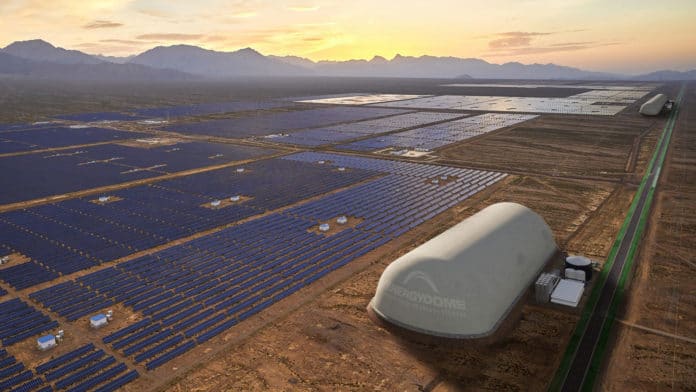An Italian energy storage company, Energy Dome, has announced the close of its $11M Series A fundraise, with the goal of deploying the first commercially viable CO2 battery in a demonstration project in its native Sardinia, Italy. The proposed 100 megawatt-hours (MWh) CO2 Battery could support the increased use of renewable power in the generation mix and address the growing need for energy storage on electrical grids.
The CO2 Battery‘s optimal charge/discharge cycle ranges from 4 to 24 hours, positioning it perfectly for daily and intra-day cycling. The company points out that this is a fast-growing market segment, not well served by existing battery technologies. Significantly, the CO2 Battery can be charged during the daytime when there is a surplus solar generation and dispatched during the subsequent evening and next-morning peaks, when solar generation falls short of demand. The modular, scalable energy storage solution will allow for solar and wind generation to be dispatchable 24 hours per day.
Using low-cost, off-the-shelf components, the company claims that its CO2 battery achieves a 75-80% round-trip efficiency. Unlike lithium-ion batteries, which degrade significantly in performance after roughly a decade of use, the battery maintains its performance during its expected 25-year operational life. This means the cost of the storage will be about half of the cost of storing with similar-sized lithium-ion batteries.
Energy Dome uses CO2 in a closed-loop cycle where it changes from gas to liquid and back to gas. The titular “dome” is an inflatable atmospheric gas holder filled with CO2 in its gaseous form.
When charging, the system draws electrical power from the grid, which powers a compressor. The compressor draws CO2 from the dome and compresses it, generating heat which is stored in a thermal energy storage device. The CO2 is then liquified under pressure and stored in liquid CO2 vessels at ambient temperature to complete the charging cycle.
The cycle is revered in the discharging process by evaporating the liquid CO2, recovering the heat from the thermal energy storage system, and expanding the hot CO2 into a turbine, which drives a generator. Electricity is returned to the grid, and the CO2 re-inflates the dome without emissions to the atmosphere, ready for the next charging cycle. The CO2 battery has up to 200 MWh in storage capacity.
The latest funding round was led by 360 Capital, joined by other investors, including Barclays’ Sustainable Impact Capital program, a division of the banking giant Barclays which takes an impact investment approach, Geneva-based multi-family office Novum Capital Partners, and Third Derivative, a global climate technology start-up accelerator founded by RMI and New Energy Nexus.
